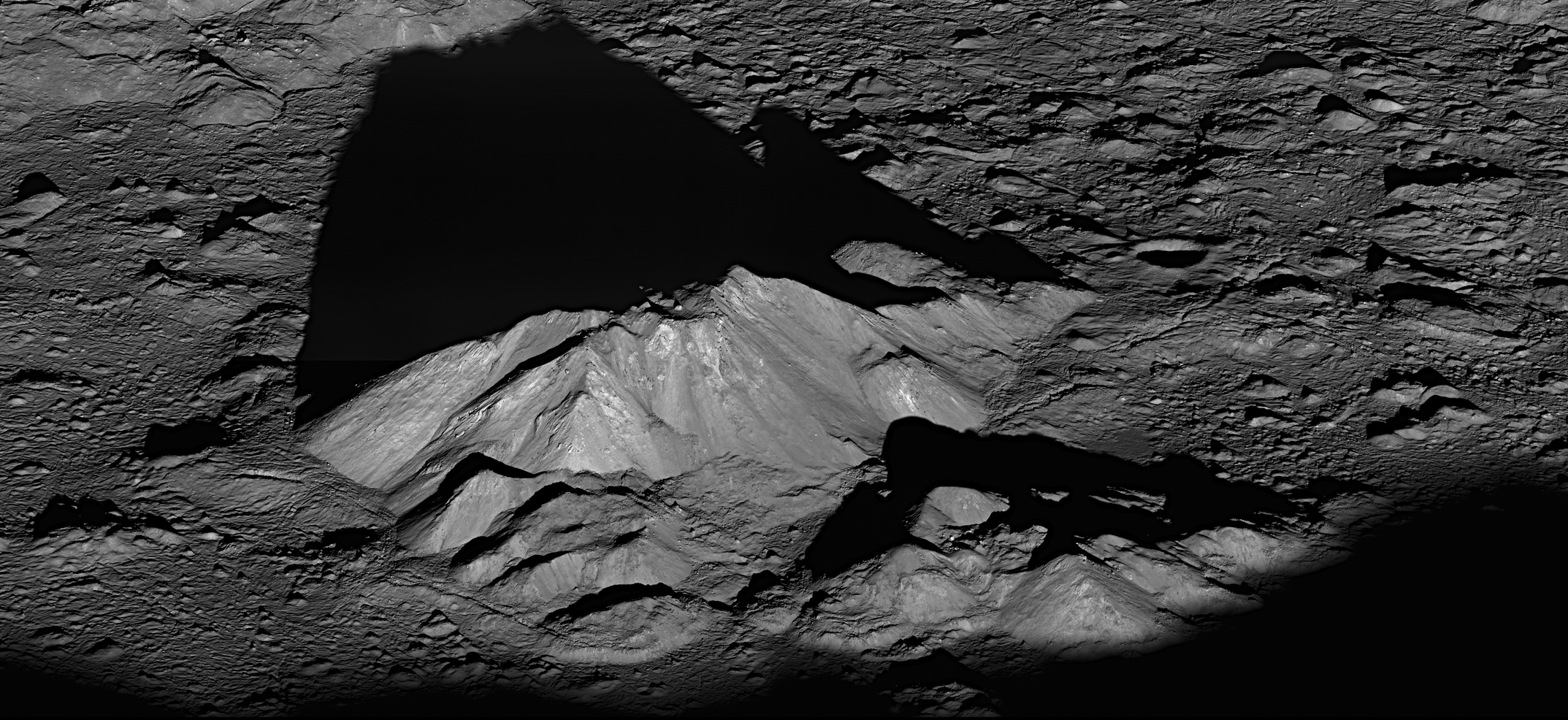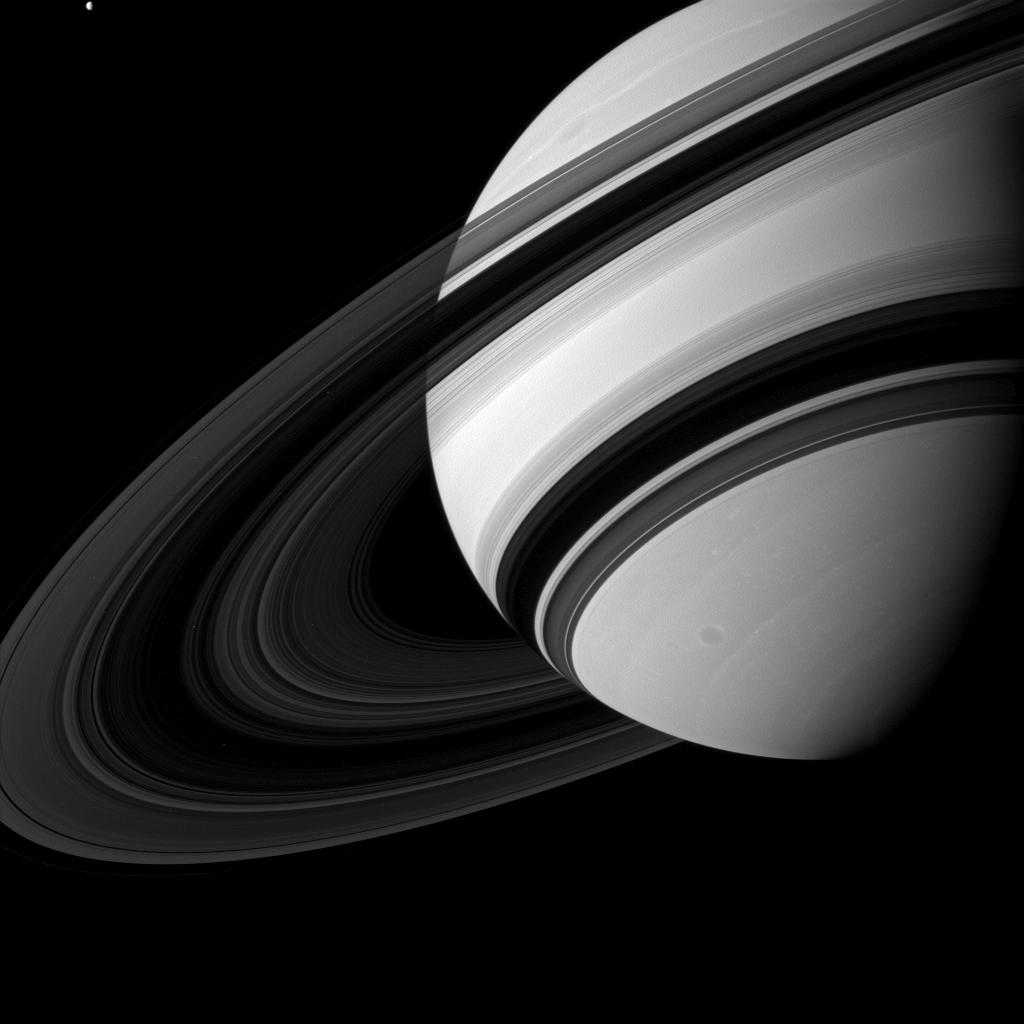
Beautiful

As NASA's Cassini spacecraft soared past Saturn's moon Titan, it recently caught a glimpse of bright sunlight reflecting off hydrocarbon seas. In the past, Cassini had captured, separately, views of the polar seas and the sun glinting off them, but this is the first time both have been seen together in the same view.
[Image: NASA/JPL-Caltech/Univ. Arizona/Univ. Idaho]
First Photos of One of the Solar System's Craziest Objects
In March 2004, the European Space Agency's Rosetta spacecraft left Earth in pursuit of comet 67P/Churyumov-Gerasimenko. Today, more than 10 years and four billion miles later, Rosetta became the first spacecraft in history to rendezvous with a comet. The probe is now soaring through space in tandem with its target—and the view is incredible.


In November, from a projected orbital distance of just 2.5 km, Rosetta will deposit a lander on the comet's surface—all this in preparation for 67P's closest pass of the Sun in more than six years. As it swings around our parent star, the mass of ice and dust will warm, shedding bits of itself along the way; Rosetta—and Philae, the lander—will have unprecedented front row seats to the show.
Money Well Spent

And to think there are people in this country who want to cut NASA's funding.
If it were up to me, I'd increase it a hundred-fold.
Io Erupts
Nasa's NEW HORIZONS spacecraft, en route to a rendezvous with Pluto in 2015, captured this amazing video in 2007 of Io, Jupiter's third largest moon, in the midst of a monumental eruption occurring from the Tvashtar volcano on the moon's northern hemisphere.
Science is cool.
Mimas, Moon of Saturn
Despina, Moon of Neptune
From APOD:
Despina is a tiny moon of Neptune. A mere 148 kilometers across, diminutive Despina was discovered in 1989 in images from the Voyager 2 spacecraft taken during its encounter with the solar system's most distant gas giant planet. But looking through the Voyager 2 data 20 years later, amateur image processor and philosophy professor Ted Stryk discovered something no one had recognized before—images that show the shadow of Despina in transit across Neptune's blue cloud tops. His composite view of Despina and its shadow is composed of four archival frames taken on August 24, 1989, separated by nine minutes. Despina itself has been artificially brightened to make it easier to see. In ancient Greek mythology, Despina is a daughter of Poseidon, the Roman god Neptune.
If that Last Post Weren't Depressing Enough…
Our Future Awaits









Duh!
The latest discovery of Nasa's Mars Curiosity rover is evidence of an ancient freshwater lake on Mars that was part of an environment that could potentially have supported simple microbial life.
The lake is located inside the Gale Crater and is thought to have covered an area that is 31 miles long and 3 miles wide for more than 100,000 years.
According to a paper published yesterday in Science Magazine: "The Curiosity rover discovered fine-grained sedimentary rocks, which are inferred to represent an ancient lake and preserve evidence of an environment that would have been suited to support a Martian biosphere founded on chemolithoautotrophy."
Beauty in Darkness
Beauty in Darkness

Saturn from Above
A view that you'll never see from Earth.
Contrary to Popular Belief, Tumblr is Not Just Full of Porn
Unless you want to include space porn:











Lots more at the link.
After looking at these I can't understand how anyone wouldn't want us to go to Mars.
This Would Probably Explain…
…why no one's come knocking at our door!

Submitted Without Comment


Life Imitating Art
I am reminded of an episode of the old Outer Limits where an air force fighter pilot and his wife are trapped in an alternate reality suspended in time—or a variation of the time dilation idea that was later used in an episode of the original Star Trek.
From iO9:
A new study suggests that small animals like birds and flies can observe movement on a finer timescale than larger creatures. Compared to us, many of these animals are able to perceive the world through a Matrix-like "bullet-time," allowing them to escape larger predators.
We know that animals sense the world in any number of ways depending on the species. Dogs, for example, have awful eyesight and low horizon line. So instead of depending on their vision, they perceive the world primarily through sounds and smells. In addition, animals have varying dynamic ranges when it comes to their senses; dogs can hear up to 40 kHz, dolphins up to 150 kHz, and bats up to an astounding 212 kHz. Much of this has to do with the various ways animals have adapted to their roles as predators and prey.
Now it appears that there's a kind of dynamic range that exists in vision, as well — and it has to do with the rate at which the world can be perceived. As the new study published in Animal Behavior shows, small animals like insects and small birds can take in more information in one second than a larger animal, like us bulky humans.
Indeed, all you need to do to get this impression is simply watch the way a small bird, like a budgie, twitches as it scans its surroundings. What looks like near-spasmodic behavior to us is an animal that's essentially working at a faster "clock rate" (so to speak). To them, humans, or larger predators, appear to move in slow motion; we likely appear impossibly slow and cumbersome through those eyes.
To measure this rate of visual perception, a team from Trinity College Dublin (TCD), Ireland, used a technique called critical flicker fusion frequency — a system that measures the speed at which the eye can process light. It works by measuring the lowest frequency of flashing at which a flickering light source is perceived as a constant. The team looked at more than 30 species, including rodents, eels, lizards, chickens, pigeons, dogs, cats and leatherback turtles.
So, for instance, at the low end of the scale, deep sea isopods (or woodlice) could only see light turning off and on four times per second. At rates just slightly faster than that, these creatures perceive the light as being constantly on. Flies, on the other hand, have eyes that react to stimulus more than four times quicker than the human eye. Compared to us, flies see the world in slow motion.
(more)
Awesomesauce!
What Would Happen if All the Ice on Earth Melted?

National Geographic has created interactive maps of what would happen if all the ice melted on earth. The United States would be particularly hard hit as would sections of Euorpe and Southeast Asia. Africa and Australia would feel it the least.
The entire northeastern seaboard would disappear, along with all of Florida and the entire Gulf Coast. San Francisco's hills would become a cluster of islands and the Central Valley an enormous bay (as it likely was in the distant past). The Gulf of California would extend northward past the latitude of the now-ennundated San Diego.
National Geographic reports:
The maps here show the world as it is now ,with only one difference: All the ice on land has melted and drained into the sea, raising it 216 feet and creating new shorelines for our continents and inland seas.
There are more than five million cubic miles of ice on Earth, and some scientists say it would take more than 5,000 years to melt it all. If we continue adding carbon to the atmosphere, we'll very likely create an ice-free planet, with an average temperature of perhaps 80 degrees Fahrenheit instead of the current 58.
Click on any of the maps to see the full size version.
Damn Cool
Can. Not. Wait.
Mercury, Bitches!
The entire surface of planet Mercury has been mapped. Detailed observations of the innermost planet's surprising crust have been ongoing since the robotic MESSENGER spacecraft first passed Mercury in 2008 and began orbiting in 2011. Previously, much of the Mercury's surface was unknown as it is too far for Earth-bound telescopes to see clearly. The above video is a compilation of thousands of images of Mercury rendered in exaggerated colors to better contrast different surface features. Visible are rays emanating from a northern impact that stretch across much of the planet, while about half-way through the video the light colored Caloris Basin–an ancient impact feature that filled with lava–rotates into view. MESSENGER has now successfully completed its primary and first extended missions.
Who Needs Aliens?
When you have this rarely-seen-in-its-native-habitat majestic 8-foot long Oarfish?
Putting Things Into Perspective
Not Bragging, But…
Robots are Assholes

Sense of Wonder

Tycho crater's central peak complex casts a long, dark shadow near local sunrise in this spectacular view that was captured by the Lunar Reconaissance Orbiter on June 10, 2011. Shown in amazing detail (click to embiggen), boulder strewn slopes and jagged shadows appear in the highest resolution yet imaged at 5 feet per pixel. The entire complex is slightly less than a mile wide, formed in uplift by the giant impact that created the well-known ray crater 100 million years ago. The summit of its central peak reaches approximately 6500 feet above the crater floor.
Maybe it's because I grew up the 1960s and 1970s and the manned space program left an indelible mark upon my psyche, but I look at an image like this and think, we must return to the moon. And at this point I don't care if it's the U.S. or the Chinese or some other country; it needs to be done.
Back in the 70s there was a loud outcry from certain sectors (and to a large degree, it remains today) that too much money was being spent on the space program; money that would be better suited to solving problems at home.
Since that time, funding for space exploration has been cut to almost nothing, and yet I see none of the social ills that plagued us in the 70s having gotten any better in the intervening years. So where did all that money go?
Keeping in mind the source of our current economic woes, do I really need to ask?
The United States currently spends over 60% of its income on the military. Can you imagine what we could do—not just in the areas of space exploration, but across the board in education, infrastructure and other areas currently so woefully underfunded—if that was cut by half? Hell, if it was cut by 20% this would be an entirely different country than it is now.
The surface area of the moon is 14.6 million square miles, roughly 3.8 times the area of the United States. C'mon folks, it's a whole new continent out there waiting to be explored! What are we waiting for?
National will and curiosity, that's what.
Out of national pride in what the U.S. used to be, I would naturallly like to see us be the ones to go back, but both national will and curiosity are sadly lacking in our current environment that is at best apathetic, or in the case of the Republicans and the low-information voters they rely on to get elected—downright hostile—to science and education. The recent election cycle has shown in no uncertain terms the level of intelligence that the people are sending to Congress ("A woman's body can shut down pregnancy in the case of legitimate rape."), and as long as teh st00pid is celebrated in society (I'm talking to you, Paris Hilton, Kim Kardashian, Honey Boo Boo, et. al.), nothing is going to change.
Sense of Wonder
Fuck You, NASA
And once again we fell for it. This was the "one for the history books" news announcement that NASA has been teasing us with for weeks. Really NASA, really?
Sounds suspiciously like another history-making announcement, but then that one was, "Whoops. It was just a weather balloon. Nothing to see here folks, move along."
This storyline is getting tired.
No alien fossils—never mind anything actually living, not even any verifiably organic compounds of Martian origin (what may have been found may have come from earth and transported board the spacecraft). Seriously, NASA? Don't you sterilize your shit before you go shipping it halfway across the solar system? We're contaminating the Martian environment before we even get to analyze it?
As Charlie Brown said, "You must think [we're] stupid."
It's no wonder certain groups see conspiracies swirling around everything you do relating to Mars, NASA. Back in 1976, the Viking landers supposedly returned definitive proof of life based on the experiments you created just for that very purpose. But then after announcing it, you backpeddled and said oh no—that was actually just some "strange chemistry."
Please.
The Phoenix lander supposedly also detected organic compounds in the soil, but again…oopsie! "Our bad. We were mistaken."
At this point I have to ask: if the experiments you send to Mars to detect life keep reporting life but not really, isn't it time to start hiring some different designers who actually know what they're doing and stop jerking us all around?
It's always, "Oh, on the next mission we'll get answers." Because constantly looking for life but never actually finding any maintains the status quo (discovery of alien life—even bacterial—would upend every organized religious system on this planet) and keeps everyone at NASA, JPL, and your various subcontractors pretty much employed for life now doesn't it?
Or at least as long as the American public keeps falling for this bullshit and funding you.
At this point I think most anyone with half a brain has accepted that there's life on Mars, as well as under the ice of Europa, and probably scattered throughout the universe, so why the continued bullshit bait-and-switch crap? Just admit that you've found it and let us move on and absorb the most momentous discovery in human history.
40 Damn Years
It's been 40 years since the we last landed on the moon. In 20 years there will be no humans alive who actually set foot there. This is inexcusable. We need to return.

And frankly, I don't care if it's us or the Japanese or the Chinese or the Russians. Humanity needs to go back. And while I seriously doubt I will see it in my lifetime, from there we need to go to Mars.












